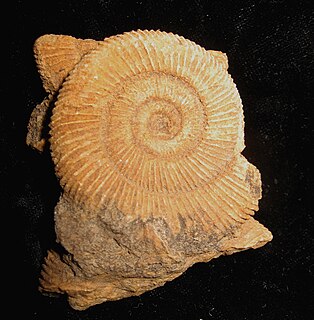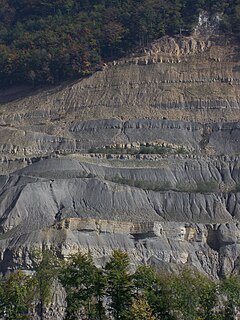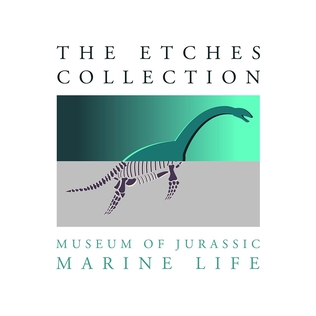
Ammonoids are a group of extinct marine mollusc animals in the subclass Ammonoidea of the class Cephalopoda. These molluscs, commonly referred to as ammonites, are more closely related to living coleoids than they are to shelled nautiloids such as the living Nautilus species. The earliest ammonites appeared during the Devonian, and the last species either vanished in the Cretaceous–Paleogene extinction event, or shortly after during the Danian epoch of the Paleocene.

Dactylioceras was a widespread genus of ammonites from the Lower Jurassic period, approximately 180 million years ago (mya).
The Early Jurassic Epoch is the earliest of three epochs of the Jurassic Period. The Early Jurassic starts immediately after the Triassic-Jurassic extinction event, 201.3 Ma, and ends at the start of the Middle Jurassic 174.1 Ma.
In the geological timescale, the Tithonian is the latest age of the Late Jurassic Epoch and the uppermost stage of the Upper Jurassic Series. It spans the time between 152.1 ± 4 Ma and 145.0 ± 4 Ma. It is preceded by the Kimmeridgian and followed by the Berriasian.
In the geologic timescale, the Bajocian is an age and stage in the Middle Jurassic. It lasted from approximately 170.3 Ma to around 168.3 Ma. The Bajocian Age succeeds the Aalenian Age and precedes the Bathonian Age.
In the geologic timescale the Bathonian is an age and stage of the Middle Jurassic. It lasted from approximately 168.3 Ma to around 166.1 Ma. The Bathonian Age succeeds the Bajocian Age and precedes the Callovian Age.
In the geological timescale, the Berriasian is an age/stage of the Early/Lower Cretaceous. It is the oldest subdivision in the entire Cretaceous. It has been taken to span the time between 145.0 ± 4.0 Ma and 139.8 ± 3.0 Ma. The Berriasian succeeds the Tithonian and precedes the Valanginian.
In the geologic timescale, the Callovian is an age and stage in the Middle Jurassic, lasting between 166.1 ± 4.0 Ma and 163.5 ± 4.0 Ma. It is the last stage of the Middle Jurassic, following the Bathonian and preceding the Oxfordian.

In the geologic timescale, the Sinemurian is an age and stage in the Early or Lower Jurassic Epoch or Series. It spans the time between 199.3 ± 2 Ma and 190.8 ± 1.5 Ma. The Sinemurian is preceded by the Hettangian and is followed by the Pliensbachian.

The Oxfordian is, in the ICS' geologic timescale, the earliest age of the Late Jurassic Epoch, or the lowest stage of the Upper Jurassic Series. It spans the time between 163.5 ± 4 Ma and 157.3 ± 4 Ma. The Oxfordian is preceded by the Callovian and is followed by the Kimmeridgian.
In the geologic timescale, the Kimmeridgian is an age in the Late Jurassic Epoch and a stage in the Upper Jurassic Series. It spans the time between 157.3 ± 1.0 Ma and 152.1 ± 0.9 Ma. The Kimmeridgian follows the Oxfordian and precedes the Tithonian.
Abbasites is an extinct genus of ammonites from the early Middle Jurassic epoch, included in the ammonitid family Erycitidae.

Asteroceras is an extinct genus of cephalopod belonging to the Ammonite subclass. These fast-moving nektonic carnivores lived during the Triassic and Jurassic periods.

Psiloceras is an extinct genus of ammonite. Psiloceras is among the earliest known Jurassic ammonites, and the appearance of the earliest Psiloceras species form the definition for the base of the Jurassic. Unlike most earlier ammonites, which had complex shell shapes and ornamentation, Psiloceras had a smooth shell.

Parkinsonia is a genus of ammonites belonging to the family Parkinsoniidae.

The Charmouth Mudstone Formation is a geological formation in England. It preserves fossils dating back to the early part of the Jurassic period (Sinemurian–Pliensbachian). It forms part of the lower Lias Group. It is most prominently exposed at its type locality in cliff section between Lyme Regis and Charmouth but onshore it extends northwards to Market Weighton, Yorkshire, and in the subsurface of the East Midlands Shelf and Wessex Basin. The formation is notable for its fossils, including those of ammonites and marine reptiles and rare dinosaur remains. The formation played a prominent role in the history of early paleontology, with its Lyme Regis-Charmouth exposure being frequented by fossil collectors including Mary Anning.

Asteroceras obtusum, the obtuse star ammonite, is an extinct species of cephalopod belonging to the ammonite subclass and to the family Arietitidae. These fast-moving nektonic carnivores lived during the lower Jurassic period, upper Sinemurian, around 189-196 million years ago.

The Etches Collection is an independent fossil museum located in the village of Kimmeridge, Purbeck, Dorset, England. It is based on the lifetime collection of Steve Etches, a fossil hunter for whom some of his finds have been named, from the local area on the Jurassic Coast, an SSI and World Heritage Site, especially around Kimmeridge Bay and the Kimmeridge Ledges.










